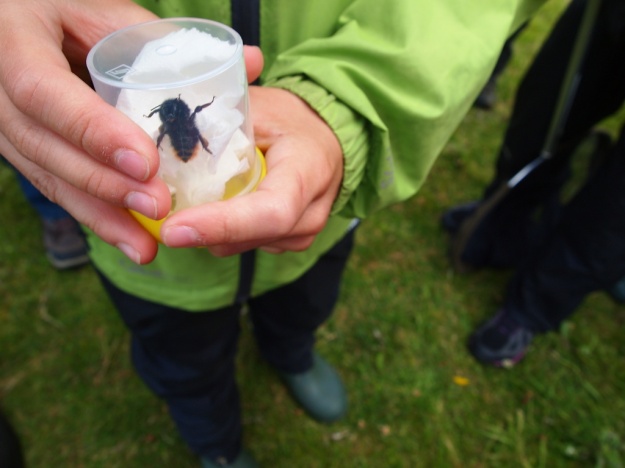On Saturday last, we attended part of the Annual Bee and Butterfly Recorders weekend held on the Belmullet Peninsula here in Co Mayo and organised by the National Biodiversity Data Centre with BirdWatch Ireland hosting.
Belmullet is a special place. It’s wild and windswept and much of it is surprisingly flat, which means the Atlantic winds just howl across it.
There are many treasures on the peninsula including Erris Head which I wrote about last year. But for the recorders weekend the habitat we were most interested in was Machair. Machair is a flat, specialised and rare, sandy habitat formed from windblown calcareous sands.

Looking for bees
Looking at the photo you may think that it is nothing special, but a closer inspection reveals a mass of flowers! And of course that is what the bees (and butterflies, but it was so windy they were out of sight) were there for.

Machair
We were looking, in particular, for the Great Yellow Bumblebee. I hadn’t seen this bumble before as it is now restricted to just a few areas on the west coast. The species is listed as endangered in Ireland. Well, we did see it! And while it may not quite live up to it’s name – it was indeed yellow (with a single black band), but ‘great’ – well pretty small really. Still it was amazing to see it.

Great Yellow Bumblebee
To make the day even better, we saw two other bumblebee species that I have not seen before. The Large Carder bee, a beautiful blond and ginger bee. And the Red-Shanked Carder bee, which is black with a red tail and red hairs (quite hard to see) on its hind legs. The Red-Shanked bee is also rare and listed as having a vulnerable conservation status. While the Large Carder is listed as near vulnerable.

Red-shanked carder bumblebee
Like all threatened species, it is important that we learn as much as we can about these species, so that proper conservation management strategies are put in place to ensure their survival. Dr Tomás Murray, Project Co-Ordinator, for the NBDC had earlier emphasised the importance of monitoring this species (and all bees and butterflies). Anyone interested in bees or butterflies can become involved in monitoring, for more information follow this link.
I would like to express my gratitude to all dedicated professionals and amateurs involved. I learned so much on the day.





How fantastic! What a brilliant thing to be part of and how encouraging that so many people were taking part. Thanks for sharing. Great pics as always x
LikeLiked by 1 person
It was indeed brilliant. Thanks!
LikeLike
Mr Snail attended a bumblebee survey day last week at a local nature reserve but, despite good weather, they didn’t record anything as rare as yours. The positive thing, though, was that they did see lots of bumblebees.
LikeLiked by 1 person
Great that they saw so many though.
LikeLike
Yes, it is encouraging considering all the threats… I guess we are lucky in rural west Wales that the absence of much arable land means there’s less use of certain chemicals locally.
LikeLiked by 1 person
..and probably more wildflowers too:)
LikeLike
What a wonderful day. I’m so impressed that you were able to catch and observe so many rare species. Who would have thought they were all there. Valuable info indeed to help their numbers grow. Good for you.
LikeLiked by 1 person
It is known as a yellow bumble site but it was great to get other species too. Just shows how valuable good wildflower habitat is.
LikeLike
An exciting outing in such a beautiful meadow. It looked very cold for summer (I shudder to think what it’d be like in winter!)
LikeLiked by 1 person
Yes cold wet and exposed!
LikeLiked by 1 person
Wow, fantastic that you encountered some rare bumbles. Great to see that there are locations like that to support them.
LikeLiked by 1 person
Just not enough and some are threatened by over grazing.
LikeLike
What a day! The large yellow had pollen on her legs so that is good to see too! Amelia
LikeLiked by 1 person
Yes meant she was part of a colony, which was a great sign
LikeLike
Pingback: Final – 17 for 2017 | Murtagh's Meadow
Pingback: Harebells | Murtagh's Meadow